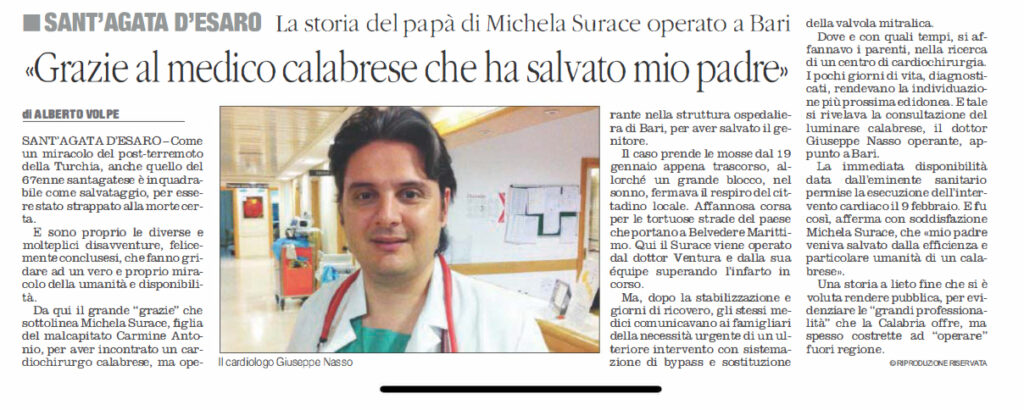Come
un miracolo del post-terremoto della Turchia, anche quello del 67enne santagatese è inquadrabile come salvataggio, per essere stato strappato alla morte certa.

Cuore ed endocardite: una tecnica innovativa per ridurre la mortalità,
pubblicata su Reviews in Cardiovascular Medicine e su Scientific Reports.
Scopri la rassegna stampa della notizia !!! Clicca qui –> PUGLIAAH02-24Endocardite su protesi _DottNasso
Much debate is still going on about the best ablation strategy—via endocardial or epicardial approach—in patients with atrial fibrillation (AF), and evidence gaps exist in current guidelines in this area. More specifically, there are no clear long-term outcome data after failed surgical AF ablation.
Background: Much debate is still going on about the best ablation strategy—via endocardial or epicardial approach—in patients with atrial fbrillation (AF), and evidence gaps exist in current guidelines in this area. More specifcally, there are no clear long-term outcome data after failed surgical AF ablation.
Methods: Since June 2008, 549 surgical AF ablation procedures through a right minithoracotomy were performed at our institution. From 2008 to 2011, a unipolar radiofrequency device was used (151 patients), whereas from 2011 to 2020 a bipolar radiofrequency device was used (398 patients). Patients were scheduled for surgery on the basis of the following criteria: recurrent episodes of paroxysmal or persistent lone AF refractory to maximally tolerated antiarrhythmic drug dosing and at least one failed cardioversion attempt. Besides the recommended follow-up by the local
cardiologist, starting from 2021, surviving patients were asked to undergo assessment of left ventricular function and to complete a questionnaire addressing quality of life and predisposing factors for recurrent AF.
Results: At a mean follow-up of 77 months, the rate of AF recurrence was 20.7% (n=114). On multivariate analysis, impaired left ventricular ejection fraction (58 patients, 51%, p=0.002), worsening of European Heart Rhythm Association (EHRA) symptom class (37 patients, 32%, p=0.003) and cognitive decline or depression (23 patients, 20%, p=0.023) during follow-up were found to be signifcantly associated with AF recurrence.
Conclusions: Surgical AF ablation through a right minithoracotomy is safe, but a better outcome could be achieved using a hybrid approach. Patients after initial failed surgical AF ablation show worsening of cardiac function, clinical status and quality of life at follow-up compared to patients with successful AF ablation.
Keywords: Atrial fbrillation, Surgical ablation of atrial fbrillation, Catheter ablation of atrial fbrillation
Il bypass aorto-coronarico è l’intervento che permette di «by-passare» cioè aggirare, un ostacolo presente in una delle piccole arterie che porta il sangue al muscolo cardiaco. L’operazione consiste nel creare una sorta di «ponte» che «scavalchi» l’ostruzione utilizzando un segmento di vaso prelevato da un’altra zona del corpo. Tradizionalmente viene usata la vena grande safena, presa dall’arto inferiore. Ora uno studio pubblicato su una rivista del gruppo Jama (Journal of American Medical Association) indica che l’utilizzo dell’arteria radiale, che scorre nel braccio, può presentare dei vantaggi. Lo studio riporta l’esperienza di specialisti in diversi centri internazionali, fra cui gli italiani Giuseppe Nasso, responsabile dell’unità operativa di Cardiochirurgia presso l’Anthea Hospital di Bari e Giuseppe Speziale responsabile delle cardiochirurgie di GVM Care & Research, accreditate con il Servizio Sanitario Nazionale. I primi risultati dopo un monitoraggio di 5 anni erano già stati pubblicati sul New England Journal of Medicine, quelli appena comunicati su Jama riferiscono i risultati a 10 anni dall’intervento. «Abbiamo concluso che questo approccio permette al paziente non solo di vivere meglio nel corso degli anni successivi, ma soprattutto di vivere più a lungo, questo perché si riduce l’incidenza di nuovi infarti e di essere sottoposto a nuove procedure di rivascolarizzazione miocardica» commenta Nasso. «L’arteria radiale, infatti, al contrario della vena safena, anche dopo tanto tempo rimane funzionante».
«Un paziente sottoposto ad intervento di bypass aortocoronarico è un paziente che di fatto ha risolto la problematica in essere, ma è doveroso seguirlo anche nel post-operatorio, spiegandogli che deve eliminare tutti i fattori di rischio che lo hanno portato alla malattia, che possono essere il fumo, la pressione arteriosa alta, una dieta con un elevato contenuto di grassi insaturi, o anche elevati valori di colesterolo e trigliceridi» sottolinea comunque Nasso. «Se non si eliminano questi fattori di rischio, qualsiasi bypass nel tempo non sarà sufficiente a risolvere la patologia coronarica ma ancora peggio si avrà una progressione della malattia sulle altre coronarie».
CLICCA QUI PER VISUALIZZARE ARTICOLO SU CORRIERE DELLA SERA